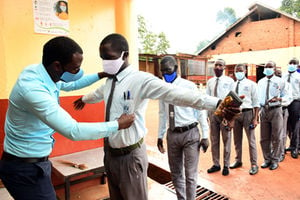Prime
Five things you should do for pigs

Pigs secured in metal panels. Photo by Rachel Mabala
What you need to know:
Castration makes male pigs more manageable when they attain sexual maturity by reducing aggression and handling challenges, writes Felix Opinya.
Pig husbandry practices are important for their welfare, but they can be painful, causing stress and discomfort if not performed with care.
They include iron injection to new-borns, teeth clipping, tail-docking, castration and identification.
Iron is required for the formation of haemoglobin, normally a challenge for piglets since most of them are born with limited supply of the mineral, thereby requiring oral supplementation or injection.
They receive an additional iron through the sow’s milk but this is still deficient until they start creep feeding.
Despite this, quantities of iron decrease rapidly and could result in piglets becoming very pale a few weeks after birth, if not supplemented.
It is, thus, advisable to give extra iron, about 1ml of a full dose for the piglet to grow healthy and faster.
Iron injections offer more value and are most preferred over oral iron supplements since injection ensures each piglet gets the exact dose.
This is best done by a qualified veterinary doctor.
Although teeth clipping is getting less common, piglets are born with needle sharp teeth which if left untrimmed, may injure the sow’s udder during suckling. Such an injury may make the sow starve the piglets to death.
Tail docking
Typically, piglets start using their teeth when competing for udder within the first 24 hours of age, which is when the clipping decision is made especially for aggressive piglets.
Only the points of the teeth should be removed, improper teeth clipping needle may result in discomfort.
Roll back the tongue during the exercise to avoid consequent injuries and use a pair of tooth clippers.
Tail docking in piglets is done primarily to reduce the risk of tail chewing or biting.
The vice results in serious wounds and bleeding, infections and sometimes spinal abscess, paralysis or even death.
It is triggered by overstocking, feed deficiencies, subnormal temperature levels, inadequate ventilation, drafts and high levels of dust in the pen.

Perform tail docking on piglets as early as possible, preferably between 24-72 hours of age, more than seven days old piglets could find the practice very painful.
Cutting the tail too short may lead to infections or a prolapse, on the other hand, too long docking is not effective.
Also be watchful to identify the first case of tail biting to adjust the living environment accordingly, for instance by adding straws to the pen.
More manageable
Castration makes male pigs more manageable when they attain sexual maturity by reducing aggression and handling challenges.
Moreover, it prevents their meat from having boar taint. While pigs are castrated before weaning, it should be carried out within the first two weeks of a piglet’s life, ensuring the animal is fit and healthy.
Identification is an important tool for maintaining health records and tracking pigs on the farm.
The most common methods used are ear notches and ear tags. Ear notching should only be performed when deemed necessary and when piglets are below 14 days old.
Non-toxic temporary markers are also used on some pig farms for the job. For ear tags, ensure that they are correctly inserted to avoid main blood vessels and ridges of cartilage.
Surgical castration is mostly done with the help of a licensed veterinary doctor, where the assistant’s role is to hold the pig in a required position.
During the procedure, the working environment should be dry and the scalpel sterilised. Castration is, however, painful regardless of a pig’s age, but if done by a qualified veterinary doctor, the pain can be controlled.
Piglets barely have their skin covered when very young, therefore, suffer when it’s cold. Heating provision using infra-red lamp help keep them warm, evading diseases like pneumonia.
Tip
When piglets are young, it is better for them to be in a clean panel or pallet pen.
Electric netting, string or wire do not work well with small piglets because they can get out.
Keep piglets in a small cattle panel pen with electric wire on the bottom until they are about 12-15 weeks old and then transfer them into pens made with electric string or wire.
Usually by this age they are trained and will not go near the electric fence.




